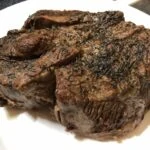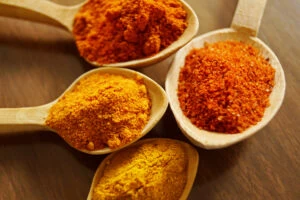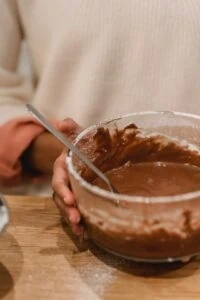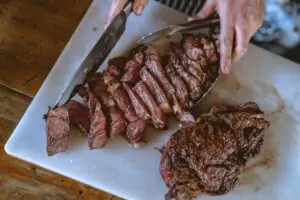Fresh ground coffee beans is a smell that drags us to the kitchen, and a brewed cup of coffee with your own grind is delectable.
If you don’t have a coffee grinder, or are avoiding yet another appliance, DIY grinders can be messy and leave you with a too-coarse, or uneven grind. This begs the question — “Can I grind coffee in my Vitamix?” Yes.
Can I Grind Coffee in my Vitamix?
Yes, you can easily substitute a coffee grinder with your Vitamix blender, with finely controllable, consistent results.
Blade grinders don’t result in the cleanest grind and don’t leave grinds as flavorful as burr grinders do, but blades can certainly result in a fine grind.
How to Grind Coffee in a Vitamix Blender
You can grind any grade of coffee beans in a Vitamix blender, either using the wet container or the Vitamix dry container. Your best bet is the dry container.
Grind Coffee Beans With the Dry Container
The coffee grinds are made using the Vitamix dry grains container, because the results offer the most consistency compared to using the wet container.
- Attach the dry grains container to your Vitamix blender and add the coffee beans
- Choose Variable Speed 1, then slowly turn on the machine, increasing to Variable 8 speed. Hold the speed for 10-20 seconds for course to fine powder
- Your coffee beans are ground and ready for a course-grind brewing method like pour over or French press
Grind for less time (10 seconds) for a course grind suitable for drip or another normal coffee, or more (20 seconds) for an extra fine, espresso grind.
How to Grind Coffee Beans in a Vitamix Without the Dry Container
If you don’t have a dry container for your Vitamix blender, you can use any Vitamix wet container with slightly larger grind results.
Using a wet container, grind your coffee beans slowly for thirty seconds. Stop occasionally to check the grind. If your coffee beans aren’t as fine as you’d like after 30 seconds, manually pulse-blend, checking the grind every four to five pulses.
Don’t wash the wet container after you’ve ground then brewed your coffee. Use the wet container to make any of the infinite options of great coffee beverages like spiced espresso.
Tips for the Best Ground Coffee Beans in a Vitamix
Using a blender to grind coffee beans isn’t recommended, but if it’s your only option, here are some ways to do it better:
Don’t Over Blend
Blend-grinding coffee beans in a Vitamix for more than 30 seconds can slightly roast the beans as the blender blades heat up. If you must grind longer, pause the blender and let the motor cool.
Blend in Batches
If you’re grinding a large amount of coffee beans, whiz up small batches to reduce your Vitamix blender’s work and limit overheating and thus possibly roasting your coffee beans. Batch grinding in a blender is more likely to give even grind.
Blend-Grind Fresh
Grinding coffee beans fresh means a more flavorful fresh coffee, and the same goes for beans ground in your Vitamix. Since oxidation whips away coffee’s ultimate flavors in 15-20 minutes after they’re ground, your coffee will have the best flavor if you get brewing as soon as you grind.
The Best Type of Coffee Bean to Grind in a Vitamix
If you’re grinding coffee beans in a Vitamix and you have your choice of coffee beans, think flavor. Choose beans with a mellow flavor and light acidity to avoid a bitter brew.
The best beans to grind in a Vitamix blender are lighter-roasted arabica beans processed using the Indian tradition.
The Vitamix blender tends to over-grind beans, or leave uneven grinds, so the coffee’s flavor tends to taste more bitter than if you had slightly courser, even grounds.
Since the bitterness of coffee beans has to do with how the beans were processed, whether they’re arabica or robusta, and how they’re roasted, choose beans that taste mellow if you’re going to work them in a Vitamix.
Recommended Beans
Some beans recommended that taste mellow and have light–as apposed to strong–acidity, include:
This bean from Mexico has a “delicate and sweet profile,” and is recommended for semi coarse grounds. Jaribilla’s beans come straight from Mexico to your door, probably fresher than you can pick them up in a local roaster–but know the best beans staying in Mexico.
This decaf coffee is lightly roasted using no chemicals, and has light acidity, with “notes of caramel, cherry, and earth.” Colectivo Coffee, the US’s current largest coffee union, offers this roast for late-night cappucino-ers like me. When grinding coffee beans in your Vitamix blender for an espresso, give the blender a rest as you find a fine or extra fine grind coffee. The blender could heat up and roast your beans!
This medium roast coffee beans blend from Ethiopia, Guatemala, and Honduras, is great for a course grind coffee in your Vitamix. Then enjoy its milk chocolate, hazelnut, and plum flavors, and listen to “So What” by Miles Davis while you sip (recommended by Three Keys itself).
Coffee Drinks in a Vitamix Blender
The Vitamix blender works as a blade grinder for coffee beans, and it also doubles as a coffee beverage maker after you’ve brewed your fresh grinds. Try whizzing up an iced coffee with fresh-picked mint leaves, or try some of Vitamix’s favorites.











